Mastering the Fret Board
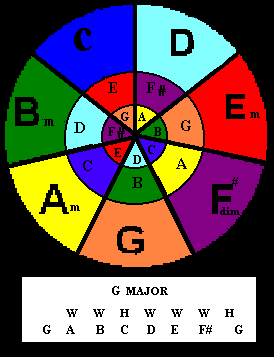 |
|
Em pentatonic would be the natural minor for the key of G. Check out key signatures before we begin. key signatures
G major pentatonic and Em pentatonic share the same notes and are relative to one another. If you are playing over the G chord or a progression in G major, use G major pentatonic, or Em pentatonic, but start on the G note.
Remember, the pentatonic root note fret fingering for all minor pentatonic scales will always be. 1-4, 1-3, 1-3, 1-3, 1-4, 1-4. So for the Em pentatonic scale you would play 1-4, 1-3, 1-3, 1-3, 1-4, 1-4, at the12th fret. The notes for Em pentatonic are: E, G, A, B and D
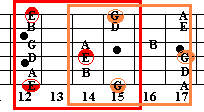
In every major key, there are always three major chords, three minor chords and a diminished chord. Look above at the circle and find all of those chords.
In the key of G major, G C and D are the major chords. Am, Bm and Em are the minor chords. The F# is the diminished chord.
A popular progression for any major key is a 1, 4, 5 progression. I, IV, V. Since we are illustrating the key of G major, the G would be the I chord, the C would be the IV chord and the D would be the V chord. If your not up on chord formula's or roman numerals, please go back and review that chapter. Check out leading to modulation part 1 and return. Check out leading to modulation part II.
I've stated throughout our lessons that every major chord has a relative minor. Each of those three major chords in the key of G and every major key has a relative or natural minor within that particular key.The Em scale is relative or natural to the G major scale. Am is relative or natural to the C major scale. Bm is natural or relative to the D chord. These are always the same, no matter what key. For Example, the Am is relative to C in the key of C as well.
Once you know the natural or relative minor scales to the major scales, playing lead guitar will be very easy to understand. I have showed you how to play the Am pentatonic scale in every position for a reason. You should know the relative minor to every major. Each of these scales share the same notes, or key signatures. Check out key signatures to get an idea of what were talking about.
It is also very important to know where all of the chords are on the complete fretboard. If you know where you can play the C chord in every position, then you could also play lead over those same positions. To understand what I'm saying, check out the C chords and different locations you could play the C chord. C chord and locations. Once you review this example, print out some blank illustrations and fill in all of the chords of the key of C major in the same fashion. By using these illustrations on a regular basis, you will master the fret board.
Putting it all together.
Since there are 3 major chords and three minor chords in every major
key, then there must also be 3 major and 3 minor scales. We will be
looking at the G major and Em pentatonic scales to start out. The
progression we will be working on will be constructed for G major
pentatonic. The pentatonic scale has only 5 notes. In G major the notes
are:
G, A, B, D and E. The key of G major has 7 notes, G, A, B, C, D, E, F# and
G.
Play the G major chord. Remember what that chord sounded like. Now play the G major pentatonic scale, in the open position, 0-3, 0-2, 0-2, 0-2, 0-3, 0-3, this is also the Em pentatonic scale, but since we are strumming the G chord, we will concentrate on the notes of G major. We can also use the Em pentatonic root note fret at the 12th fret. 1-4, 1-3, 1-3, 1-3, 1-4, 1-4 Below. But once again we need to concentrate on the G note. It should sound good, because the Em is natural and share the same notes of G major. You would always try to play on the notes of the chord your playing. For example, the notes that make up the G chord are, G, B and D. You would work around those notes for the G chord.
If we wanted to use the Em pentatonic scale for the Em chord, then we would write a progression based on the Em scale. This progression would look more like, Em, Bm, Am, Em. Or maybe, Em, D, Am, Em. The minor progressions tend to give the sadder sound compared to the major progressions that give that happy sound. I prefer the darker sadder sounds of the minors.
Listen to this lead and electric guitar rhythm. The rhythm guitar is playing only the G power chord and the Em chord. The lead uses the orange box 3rd fret over the G chord and the 1st red box over the Em chord. During the Em chord, the lead jumps to the second red box.

| Illustration 1 G major and Em pentatonic scale. |

Listen to the Em pentatonic scale in the open position. This is played from the open Low E string to the open high E string. Use the notes in the red box to the upper left. The tablature has been included above to play the Em pentatonic scale in the open position. This is also the first position of the G major pentatonic scale. G major and Em share the same notes. Strum the Em chord and the G chord while the scale is playing. Notice how each sounds and harmonizes with the scale.
The illustration above shows the G major pentatonic scale and notes. It also shows the Em pentatonic scale. These two scales have the same notes. G is the relative major to Em. Em is the relative minor to G major. Once again the pentatonic scale has 5 notes. Every pentatonic scale has 5 notes. For G major the notes are G, A, B, D and E. Notice that E is the 5th note. This means that in every major pentatonic scale, the 5th note will be the relative minor scale.
The notes of C major pentatonic are C, D, E, G and A. Notice that A is the 5th note. So A is the relative minor to C major.
When you write a song, you can write it based in a major scale or a minor scale. In this lesson we will start with a major progression in the key of G major. Strum the chords, G, C and D. Now play the notes of the G major pentatonic scale below. These notes will blend in nice with these chords. These chords are right out of the key of G major. You can play all of these notes over each of the chords in the progression G C D, or you can mix in different scales as you play over each chord.


| Illustration 2 |
Em pentatonic and G major pentatonic. Notice the G chord and Em chord in the Red box. G chord has the notes, G, B and D, Em has the notes, E, B and G.
If you wanted to, you could play the C major pentatonic scale over the C chord. C major pentatonic and Am pentatonic share the same notes. So recall the position of Am starting on the 12th fret or position. Go back and check out this position of the also go back and check out the position at the C note 8th fret Am pentatonic scale. Strum the C chord and play from C to C using the illustration below. You can play over the C chord C, E and G, using the Am pentatonic scale below. This will allow you to play the C major pentatonic scale and the G major pentatonic scale in the same position. Of course you could jump to the 8th fret and play the C major pentatonic scale or even the 5th fret and play the Am root note fret for the C. But concentrate on the C chord and notes.
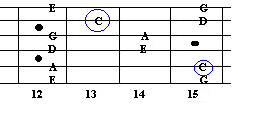 |
|
 |
|
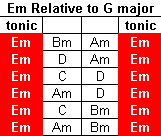 |
|
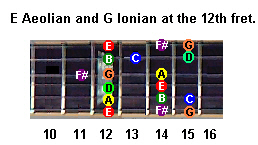 |
|
 |
|

 |
|
 |
|

The illustration above shows a different fingering pattern to play the key of G major or Em. Recall the notes in the key of G major are: G A B C D E F# and G. You can play these notes all over the fretboard using different fingering patterns. In the second part of the lead we jumped to this position and started with the B note at the 7th fret. In the first part of the lead we started on the G note 12th fret. This will work good because the G and B notes are in the Em chord. The notes in the Em chord are E G and B. We could have played the second part of the lead at the 12th fret too, but the fingering pattern was easier to play at the 7th fret. Try to play the rhythm and the lead. You can find all these chords in the chords chapter.
Assignments:
| Practice the hammer-ons, bends, pull-offs. | |
| Practice the Am grouping of 5 different positions in the Am pentatonic scale. Once you have this memorized, convert it to the G minor pentatonic scale. This could be done easily by moving all the notes down two frets. | |
| Use triplets on each scale above. Play triplets in every pattern. | |
| Practice the root 6 and root 5 bar chords. | |
| More root 6 bar chords for your reference. | |
| Practice playing G major pentatonic scale at the open position, third fret, 12th and 15th frets. Use illustration 1 above. | |
| Use illustration 1 G major pentatonic scale to play over the G major progression. | |
| Lay down the G, C and D chords on cassette and play the G major pentatonic scale over them. | |
| Lay down just the G chord and play G major pentatonic over this chord, use illustration 2 above. | |
| Lay down just the C chord and play just the C major pentatonic scale over it, illustration 3 above. | |
| Use illustration 4 above to play over the C chord. | |
| Figure out how to play D major pentatonic. Move the fingering of C major pentatonic from the 8th fret to the 10th fret and you have created the D major pentatonic scale. D, E, F#, A, B. Notice each of these notes are in the key of G major too. | |
| Learn the notes in the key of G major and all the other scales included. Once you learn them play them over the progressions you have studied. | |
| Study and play the G major pentatonic scale and all the other scales included. | |
It's now time to go to the progression in the key of G major, using the root 6 and root 5 bar chords. Good Luck, From the Jam Room |

